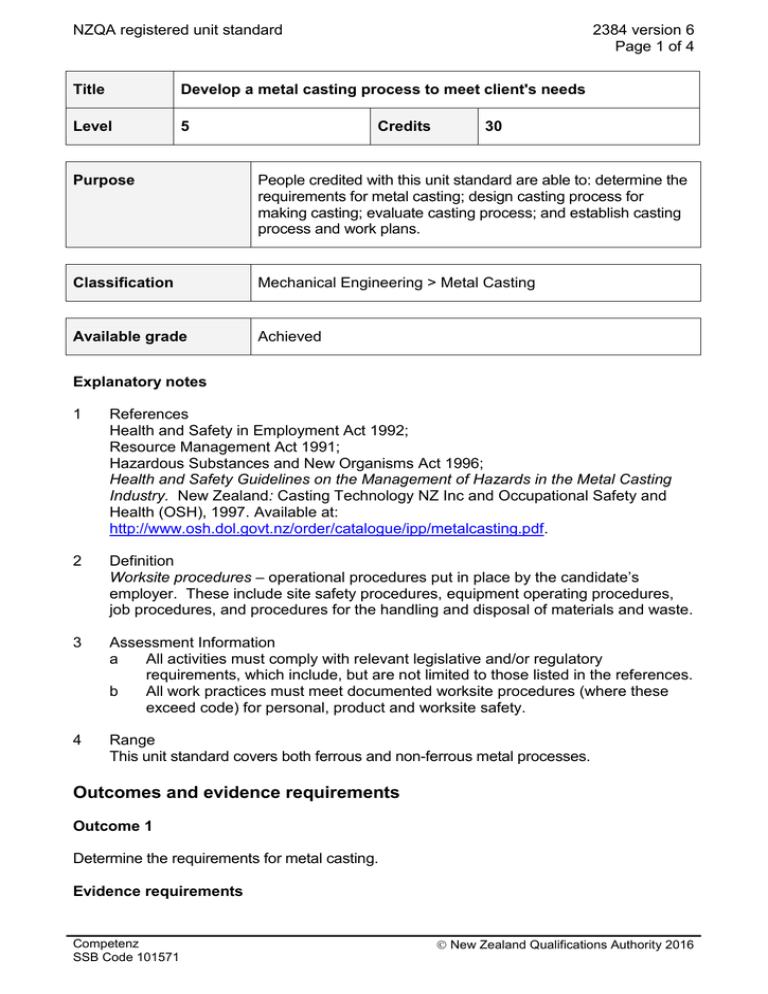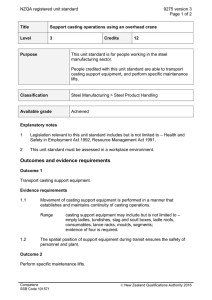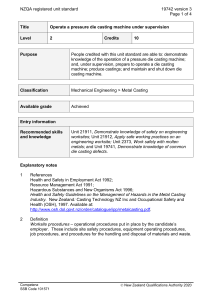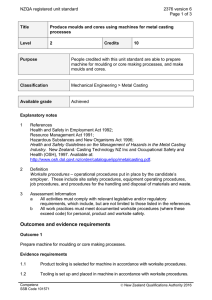NZQA registered unit standard 2384 version 6 Page 1 of 4
advertisement

NZQA registered unit standard 2384 version 6 Page 1 of 4 Title Develop a metal casting process to meet client's needs Level 5 Credits 30 Purpose People credited with this unit standard are able to: determine the requirements for metal casting; design casting process for making casting; evaluate casting process; and establish casting process and work plans. Classification Mechanical Engineering > Metal Casting Available grade Achieved Explanatory notes 1 References Health and Safety in Employment Act 1992; Resource Management Act 1991; Hazardous Substances and New Organisms Act 1996; Health and Safety Guidelines on the Management of Hazards in the Metal Casting Industry. New Zealand: Casting Technology NZ Inc and Occupational Safety and Health (OSH), 1997. Available at: http://www.osh.dol.govt.nz/order/catalogue/ipp/metalcasting.pdf. 2 Definition Worksite procedures – operational procedures put in place by the candidate’s employer. These include site safety procedures, equipment operating procedures, job procedures, and procedures for the handling and disposal of materials and waste. 3 Assessment Information a All activities must comply with relevant legislative and/or regulatory requirements, which include, but are not limited to those listed in the references. b All work practices must meet documented worksite procedures (where these exceed code) for personal, product and worksite safety. 4 Range This unit standard covers both ferrous and non-ferrous metal processes. Outcomes and evidence requirements Outcome 1 Determine the requirements for metal casting. Evidence requirements Competenz SSB Code 101571 New Zealand Qualifications Authority 2016 NZQA registered unit standard 1.1 Client's requirements for casting are clarified relevant to casting size, shape, material cost, quantity, and time required. Range 1.2 metal specification, surface finish, internal integrity, weight, number, criticality of dimensions. Moulding mediums are evaluated in accordance with production and client's requirements. Range 1.4 model, part, sketch, drawing, specification. Casting requirements are analysed in accordance with client's need. Range 1.3 2384 version 6 Page 2 of 4 sand, permanent moulds, die casting, ceramic, investments. Casting medium is established that will meet production and client’s requirements. Outcome 2 Design casting process for making casting. Evidence requirements 2.1 Pouring system is established for casting process to meet client's requirements. Range 2.2 Runner system requirements are calculated in accordance with worksite procedures. Range 2.3 pressurised, un-pressurised or filtration, in-mould inoculation requirements. runners and ingate, pouring velocity, feeding range, feeding design, contact area. Feeding system is established for casting process to meet client’s requirements. Range material solidification, thermal gradient, contact area, chill requirements, yield requirements, downstream processes. 2.4 Casting arrangements and drawings for pattern and tooling specification are established in accordance with worksite procedures. 2.5 Cost of production is confirmed with client within the required period of time in accordance with worksite procedures. Range manual or computer produced documentation. Outcome 3 Evaluate casting process. Evidence requirements Competenz SSB Code 101571 New Zealand Qualifications Authority 2016 NZQA registered unit standard 2384 version 6 Page 3 of 4 3.1 Production yield is evaluated in accordance with worksite procedures. 3.2 Trial casting is evaluated for yield, cost, and quality in accordance with worksite procedures. 3.3 Casting process documentation is completed in accordance with worksite procedures. Outcome 4 Establish casting process and work plans. Evidence requirements 4.1 Casting process is determined in accordance with production and client's requirements. 4.2 Process plans are prepared in accordance with worksite procedures. Range 4.3 production, costing. Plans and costing are provided for client within the required period of time in accordance with worksite procedures. Planned review date 31 December 2014 Status information and last date for assessment for superseded versions Process Version Date Last Date for Assessment Registration 1 25 October 1994 31 December 2012 Revision 2 14 April 1997 31 December 2012 Revision 3 5 January 1999 31 December 2012 Review 4 19 October 1999 31 December 2012 Review 5 19 May 2006 N/A Rollover and Revision 6 17 November 2011 N/A Consent and Moderation Requirements (CMR) reference 0013 This CMR can be accessed at http://www.nzqa.govt.nz/framework/search/index.do. Please note Providers must be granted consent to assess against standards (accredited) by NZQA, before they can report credits from assessment against unit standards or deliver courses of study leading to that assessment. Competenz SSB Code 101571 New Zealand Qualifications Authority 2016 NZQA registered unit standard 2384 version 6 Page 4 of 4 Industry Training Organisations must be granted consent to assess against standards by NZQA before they can register credits from assessment against unit standards. Providers and Industry Training Organisations, which have been granted consent and which are assessing against unit standards must engage with the moderation system that applies to those standards. Requirements for consent to assess and an outline of the moderation system that applies to this standard are outlined in the Consent and Moderation Requirements (CMR). The CMR also includes useful information about special requirements for organisations wishing to develop education and training programmes, such as minimum qualifications for tutors and assessors, and special resource requirements. Comments on this unit standard Please contact Competenz qualifications@competenz.org.nz if you wish to suggest changes to the content of this unit standard. Competenz SSB Code 101571 New Zealand Qualifications Authority 2016





